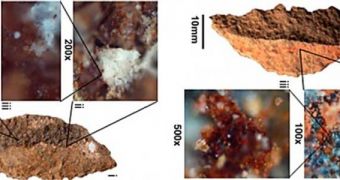According to recent investigations, it would appear that Stone Age people were a lot smarter than first thought. The conclusion was reached once experts managed to reverse-engineer a type of ancient superglue, which hinted at the fact that its makers were people with a high degree of cognitive skills. Used primarily to make stones stick to wooden shafts, the adhesive substance was not just an ordinary sticky substance, but one that most certainly required a high degree of skills and patience to do right.
“These artisans were exceedingly skilled; they understood the properties of their adhesive ingredients, and they were able to manipulate them knowingly,” archaeologists from the University of Witwatersrand, who conducted the new research, say in a new study. Further details of their finds were published in the May 11th issue of the journal Proceedings of the National Academy of Sciences (PNAS). Historians share that the first such adhesive substances were used on hand-made tools as far back as 70,000 years ago.
Thus far, archaeologists and anthropologists have held symbolic art as the main indicator of whether a specific population had a high degree of cognitive skills or not. They considered that the ability to symbolize modern occurrences, as well as their daily lives, were the main things to look for in an ancient population. But, with finding just how much work needed to go into making a simple adhesive paste, the experts now believe that preparing the stuff was an equally, if not more, challenging task for the early human brain.
“The glue maker needs to pay careful attention to the condition of ingredients before and during the procedure and must be able to switch attention between aspects of the methodology. To hold many courses of action in the mind involves multitasking. This is one trait of modern human minds, notwithstanding that even today, some people find multilevel operations difficult,” the archaeologists write in the PNAS study, Wired reports.
The glue itself was made up from acacia gum, which is a naturally occurring adhesive produced by the acacia tree, as well as from a mystery pigment. The researchers have concluded that it was the pigment that gave the adhesive the ability to last for a long time. If one had used acacia gum alone, the tools would have broken up shortly. In addition, the preparation process was very complex, and required several days to complete. Fires had to be kept up all day and night, with different types of wood for each time of the day.

 14 DAY TRIAL //
14 DAY TRIAL //